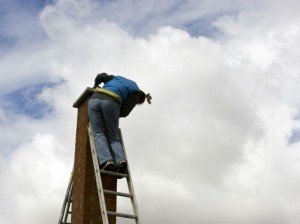If your home has a chimney, you’ll have to have it cleaned sooner or later; it’s recommended that you have it done yearly at the very least. The National Fire Protection Association (NFPA) and Chimney Safety Institute of America (CSIA) classify chimney inspections into three categories: Level 1, Level 2, or Level 3. Each level of inspection covers specific items depending on the equipment and how it is vented to the outside of your home. Taking an in-depth look at all three levels will give you a clearer understanding of what’s completed during each and how each subsequent level builds on the work completed during the previous level(s).

Having your chimney inspected and cleaned annually helps minimize any safety risks and maximizes performance.
Levels of Inspection
1.Level 1 – these are completed during a routine chimney cleaning and, as such, should be carried out annually. This more routine level of evaluation is the recommended course of action when the conditions of use have not changed over the past year. These inspections are limited in scope to the portions of the chimney’s exterior and interior that are easily accessible as well as the portions of the fireplace and flue that are readily accessible. The technician will look to gauge the condition of the flue and chimney structure as well as your basic fireplace installation and connections. The technician will also check to make sure that the chimney is free of obstructions and combustible deposits.
2.Level 2 – these are more detailed and thorough than the previous level and are recommended either when the conditions of use have changed during the past year or when a Level 1 inspection revealed an issue that warrants a more thorough inspection. A few notable issues that may call for a more in-depth inspection are homeowners opting to convert their traditional fireplace to a gas unit or when an event has occurred that could have compromised the chimney in some way (e.g., chimney fire, earthquake, or foundation settling). It’s also recommended upon the sale or transfer of the property. These inspections include everything a Level 1 inspection would include as well as the inspection of accessible areas of the attic, basement, and crawlspace and a video evaluation of the inside of your chimney.
3.Level 3 – these are the most in-depth of all the inspection types and are conducted after either a Level 1 or Level 2 inspection has revealed a major issue in parts of the chimney and/or flue that are not easily accessible. These inspections include all of the areas covered in Level 1 and Level 2 inspections as well as inspection of otherwise concealed areas to further investigate known or suspected problems. Because certain portions of Level 3 inspections require some sort of demolition to, within, or around your home, the technician will discuss this work with you prior to beginning anything.
That’s a lot of information to pack into one blog. The information is, however, extremely important. Understanding the general scope of work required with each level of inspection is critical to being an informed homeowner and consumer. We want all of our customers to be pleased with the work we do and not to be blindsided by the costs that go along with it. We wish you a happy and safe holiday season.
